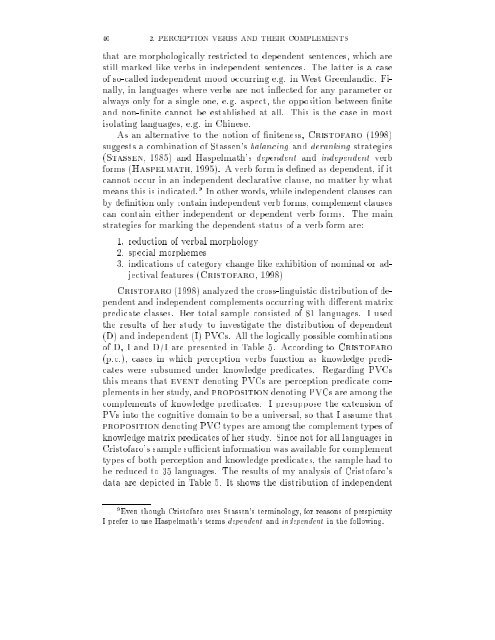Perception verb complements in Akatek, a Mayan language
Perception verb complements in Akatek, a Mayan language
Perception verb complements in Akatek, a Mayan language
Create successful ePaper yourself
Turn your PDF publications into a flip-book with our unique Google optimized e-Paper software.
40 2. PERCEPTION VERBS AND THEIR COMPLEMENTS<br />
that are morphologically restricted to dependent sentences, which are<br />
still marked like <strong>verb</strong>s <strong>in</strong> <strong>in</strong>dependent sentences. The latter is a case<br />
of so-called <strong>in</strong>dependent mood occurr<strong>in</strong>g e.g. <strong>in</strong> West Greenlandic. F<strong>in</strong>ally,<br />
<strong>in</strong> <strong>language</strong>s where <strong>verb</strong>s are not <strong>in</strong> ected for any parameter or<br />
always only for a s<strong>in</strong>gle one, e.g. aspect, the opposition between nite<br />
and non- nite cannot be established at all. This is the case <strong>in</strong> most<br />
isolat<strong>in</strong>g <strong>language</strong>s, e.g. <strong>in</strong> Ch<strong>in</strong>ese.<br />
As an alternative to the notion of niteness, Cristofaro (1998)<br />
suggests a comb<strong>in</strong>ation of Stassen's balanc<strong>in</strong>g and derank<strong>in</strong>g strategies<br />
(Stassen, 1985) and Haspelmath's dependent and <strong>in</strong>dependent <strong>verb</strong><br />
forms (Haspelmath, 1995). A <strong>verb</strong> form is de ned as dependent, if it<br />
cannot occur <strong>in</strong> an <strong>in</strong>dependent declarative clause, no matter by what<br />
means this is <strong>in</strong>dicated. 9 In other words, while <strong>in</strong>dependent clauses can<br />
by de nition only conta<strong>in</strong> <strong>in</strong>dependent<strong>verb</strong> forms, complement clauses<br />
can conta<strong>in</strong> either <strong>in</strong>dependent or dependent <strong>verb</strong> forms. The ma<strong>in</strong><br />
strategies for mark<strong>in</strong>g the dependent status of a <strong>verb</strong> form are:<br />
1. reduction of <strong>verb</strong>al morphology<br />
2. special morphemes<br />
3. <strong>in</strong>dications of category change like exhibition of nom<strong>in</strong>al or adjectival<br />
features (Cristofaro, 1998)<br />
Cristofaro (1998) analyzed the cross-l<strong>in</strong>guistic distribution of dependent<br />
and <strong>in</strong>dependent <strong>complements</strong> occurr<strong>in</strong>g with di erent matrix<br />
predicate classes. Her total sample consisted of 81 <strong>language</strong>s. I used<br />
the results of her study to <strong>in</strong>vestigate the distribution of dependent<br />
(D) and <strong>in</strong>dependent (I) PVCs. All the logically possible comb<strong>in</strong>ations<br />
of D, I and D/I are presented <strong>in</strong> Table 5. Accord<strong>in</strong>g to Cristofaro<br />
(p.c.), cases <strong>in</strong> which perception <strong>verb</strong>s function as knowledge predicates<br />
were subsumed under knowledge predicates. Regard<strong>in</strong>g PVCs<br />
this means that event denot<strong>in</strong>g PVCs are perception predicate <strong>complements</strong><br />
<strong>in</strong> her study, and proposition denot<strong>in</strong>g PVCs are among the<br />
<strong>complements</strong> of knowledge predicates. I presuppose the extension of<br />
PVs <strong>in</strong>to the cognitive doma<strong>in</strong> to be a universal, so that I assume that<br />
proposition denot<strong>in</strong>g PVC types are among the complementtypes of<br />
knowledge matrix predicates of her study. S<strong>in</strong>ce not for all <strong>language</strong>s <strong>in</strong><br />
Cristofaro's sample su cient <strong>in</strong>formation was available for complement<br />
types of both perception and knowledge predicates, the sample had to<br />
be reduced to 35 <strong>language</strong>s. The results of my analysis of Cristofaro's<br />
data are depicted <strong>in</strong> Table 5. It shows the distribution of <strong>in</strong>dependent<br />
9 Even though Cristofaro uses Stassen's term<strong>in</strong>ology, for reasons of perspicuity<br />
I prefer to use Haspelmath's terms dependent and <strong>in</strong>dependent <strong>in</strong> the follow<strong>in</strong>g.

















